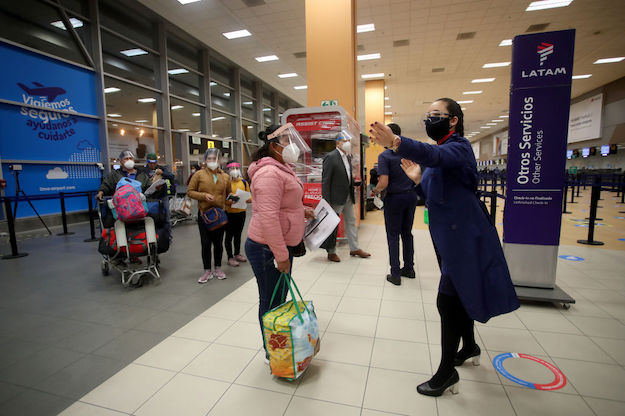Three decades ago, as a young diplomat in Nicaragua, I looked on in surprise as workers loaded hundreds of pounds of freshly caught sea bass from the Caribbean shore onto a LACSA (now Avianca) flight bound for the United States.
Such scenes are no longer cause for surprise. Latin America’s shift to higher-value exports has been accompanied by a shift from sea- to air-based shipping, and items such as freshly cut flowers, specialty fruits and vegetables, fresh seafood (both farmed and wild) and late-season textiles often travel to market by air, sometimes stored just feet below departing tourists in the belly of a passenger aircraft. This transition to air-based shipping — accompanied by an expansion in receptive tourism, which now accounts for 8.1% of the region’s GDP, according to the International Air Transportation Association (IATA) — means Latin American economies have grown especially dependent on the aviation industry. Unfortunately, this trade is currently threatened by the COVID-19 crisis; without support from governments in the region, Latin America’s aviation industry is at severe risk.
On March 16, 2020, then-president of Peru Martín Vizcarra became the first leader in the region to institute a ban on international and interprovincial travel, as well as to put in place quarantine and curfew measures, suspending regularly scheduled foreign and domestic air service. Other countries quickly followed suit. Today, though scheduled service has resumed, significant restrictions remain in place.
Not surprisingly, passenger traffic has suffered dramatically. IATA estimates that air passenger traffic in the region decreased by nearly two-thirds for the year 2020; regional passenger carriers are estimated to have posted losses of $5 billion for the year. And though passenger traffic has staged a modest recovery more recently, especially in resort tourism traffic, abrupt drop offs in the first half of 2020 saw declines of as much as 80% compared to the same period a year earlier.
Faced with plummeting traffic, the region’s three largest air carriers, LATAM Airlines, Avianca and Grupo Aeroméxico, each filed for Chapter 11 bankruptcy in U.S. courts in 2020. As a group, regional carriers pared back their routes significantly, with LATAM exiting the Argentine market and cutting back in Chile while focusing efforts in the Brazilian, Peruvian and Bolivian markets. Avianca, for its part, discontinued service to Peru. Smaller carriers have fared similarly; TAME, headquartered in Ecuador, shut down; Interjet, a Mexican carrier, cut back service, while Panama’s COPA airlines shut down operations before reopening late in 2020.
All of this runs contrary to recent progress made in the liberalization of the region’s air transport sector. Over the past three decades, the United States negotiated open skies or greatly liberalized air transport services agreements — accords that reduce restrictions on air service between the U.S. and the region — with Mexico, Guatemala, Honduras, El Salvador, Nicaragua, Costa Rica, Panama, Colombia, Suriname, Guyana, Ecuador, Brazil, Peru and Chile. Latin American nations have signed similar agreements with European and Asian countries. This progress is now in jeopardy. According to IATA’s connectivity index, a measurement based on the number of major city pairs connected by air service, Latin America’s air connectivity fell by 91% during the COVID-19 crisis. If not corrected, the loss of direct connections could make travel overly complicated and time consuming, resulting in decreased investment and tourism in the region.
In the absence of government financial support, it is difficult to see how the industry will be able to keep pace as the region’s and the world’s economies recover, as vaccines become available and COVID-19 is brought under control. Indeed, whereas U.S., European and other carriers around the world have received billions in assistance, Latin American carriers have not generally received state aid to help cope with the fallout from COVID-19. In September, a Colombian Court even blocked a U.S. $370 million loan from the Government of Colombia to Avianca for this purpose. Despite calls from IATA for Latin American governments to find ways to strengthen and support regional air carriers, governments in the region have not taken sufficient action. They would do well to recognize the industry’s importance for their economies before it is too late.
___
Urs is a retired American diplomat, having served as U.S. Ambassador to Peru from 2017-2020, and as the U.S. government’s lead commercial aviation negotiator from 2010-2014. He is currently CEO of the Air Transport Consultancy, LCC.







